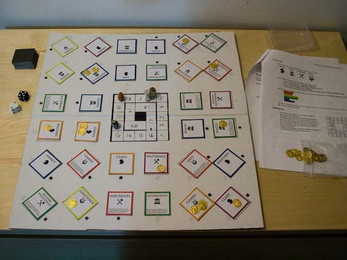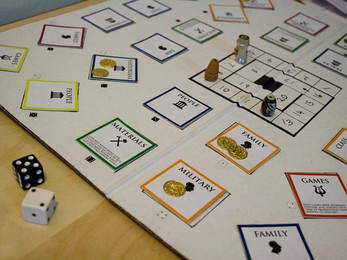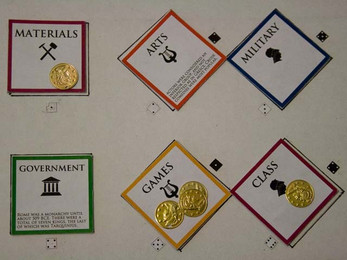Museum Match Board Game
A downloadable game
Museum Match
The recently deceased Lord FitzRoy Fitzsimons Esq. has left an endowment to his alma mater to be used for the construction of a museum to house and display his considerable collection of ancient Roman artifacts. The university has appointed you and three of your peers to oversee day to day operations of the museum. Each of you have an idea of how to best organize the exhibits, and your bulging academic egos leave little room for compromise or cooperation.
Overview
Museum Match is a game of competitive curation in which 4 players compete for the most points by strategically swapping Exhibit Tiles and acquiring Visitor Tokens.
Game Pieces
- The game board
- A pair of dice (1 black, 1 white)
- 4 Score Markers
- 40 Visitor Tokens
- 48 Exhibit Tiles
The Board

Each player is only allowed to manipulate the two rows of Exhibit Tiles in front of them. Every number on the coloured dice is represented on a space that the Exhibit Tiles occupy. The 6 spaces on the player's left are tied to the black die, and those on the right to the white die.
The four Exhibit Tile spaces in each corner are shared with the neighbouring player, but with different die roll values. For example, Player 1's 5-Black (Bottom row, second from left) is Player 2's 3-White (Top row, far right)
A scoring track runs along the inside, allowing players to keep score using their score marker.
Exhibit Tiles
The Exhibit Tiles are grouped into four Collections of 12 tiles:
|
Society |
History |
Technology |
Culture |
|
|
|
|
|
Each Collection contains four Exhibition groups of 3 tiles:
- Culture: Arts, Games, Language, Religion
- History: Government, Historians, People, Places
- Society: Class, Family, Law, Military
- Technology: Civil Engineering, Machines, Materials, Military Engineering
Each individual Exhibition Tile is further part of one of six colour-coded Theme groups of 8 tiles:
- The Proletarii
- The Equites
- The Senatorial Class
- Military Expansion
- Politics
- Infrastructure
The flavour text at the bottom of each Exhibit Tile is for educational purposes only and does not affect how the game is played.
Setting Up
- Determine who will go first using any method agreed upon by the group.
- The player who goes first shuffles all 48 Exhibit Tiles and deals 32 of them face up into a square, two rows deep, beginning with the corner in his or her top left and working clockwise. See diagram.
- The remaining cards are placed face-down in a stack in the centre.
- Each player chooses a scoring marker and places it at the beginning of the scoring track.
Game Rules
Rolling the Dice
The dice are rolled at the beginning of a player's turn. The numbers on each die determine the Active Tiles for that turn. For example, if the black die turns up a 5 and the white die a 2, then the #5 space on the player's left and #2 on the right become the Active Tiles that can be played during the turn.
Playing the Active Tiles
Only one action can be played on each Active Tile per turn, and an action MUST be taken.
- A Visitor Token can be placed on the Active Tile. There can be multiple tokens per tile.
- The Active Tile can be swapped with an adjacent Exhibit Tile. You can only swap within your playable two rows. For example, swapping your 1-Black with your opponent's 4-White is not allowed, but that player would be allowed to make such a swap as from his or her perspective 4-White to 5-White is allowed. Any Visitor Tokens already on the Active Tile remain with it if moved.
- Active Tiles that are not shared (3-Black, 6-Black, 1-White, 4-White) can be swapped with a card off the top of the stack in the middle. The tile being swapped off the board is discarded face up next to the stack. All Visitor Tokens are removed from the tile you are swapping out and not scored.
Scoring and Winning the Game
The goal is to gain points by having tokens on valid sets of 3 tiles. A set can be made from any 3 adjacent tiles on the same row. The spaces numbered 1-3 (both white and black) are considered a player's top row, and 4-6 are likewise on the bottom row.
Each exhibition tile has three attributes: Collection (Icon), Exhibition (Text), and Theme (Colour). A valid set is composed of 3 cards with at least one attribute that is matching. For example, 3 cards of the same colour OR with the same text OR the same icon. More points are given for matching more than one attribute in a single set.
Players may score ONE of their own valid sets by calling it at the end of their turn. They are not obligated to do so. The score marker is moved appropriately, visitor tokens removed, and tiles placed in the centre discard pile. Three new cards are drawn from the top of the face down stack and placed from left to right in the empty spaces. If there are not enough cards in the face down stack the discard pile is shuffled and added to it.
Scoring Multipliers
When scoring a set you multiply the number of Visiter Tokens on the tiles by a number determined by the kind of match:
1x - Same as number of visitor tokens. Icon match.
2x - Colour match.
4x - Colour AND Icon match.
5x - Icon AND Title match.
Victory Condition
The first player to acquire 20 points wins.
| Status | Released |
| Category | Physical game |
| Author | Viewport Games |






